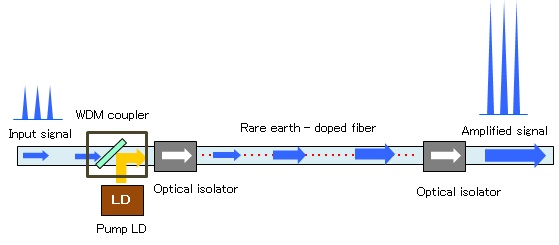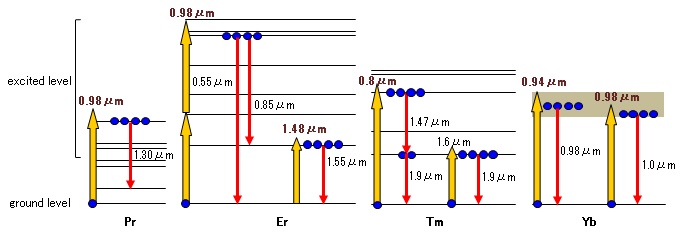Last updated on 05/7/2021
Optical fiber amplifier is one of the key instruments for modern optical communication systems. A rare-earth-doped optical fiber amplifier, in which optical gain is provided by stimulated emission from rare-earth elements, is the most widely used type of optical fiber amplifier.
A schematic of a rare-earth-doped fiber amplifier is shown in Figure 1. The input signal is combined with the pump light by the WDM coupler, and is amplified by the pump light via stimulated emission in the rare-earth-doped fiber. Optical isolators are placed both at the input and output, in order to stabilize signal amplification by eliminating unwanted back reflection from the output port, as well as to prevent the amplifier from operating as a fiber laser.

Figure 1: Schematic of rare-earth-doped fiber amplifier.
Figure 2 shows energy diagrams of various rare-earth elements, showing both pump and emission wavelengths. A rare-earth element absorbs pump light and is raised to an excited level (shown as an upward arrow), and eventually drops to a lower level by emitting light (shown as a downward arrow).

Figure 2: Energy diagram and pump/emission wavelengths of various rare-earth elements (Upward arrow: pump wavelength, downward arrow: emission wavelength)
Erbium (Er) shows strong fluorescence in the C-band and L-band and thus erbium-doped fiber amplifier (EDFA) is the most common optical fiber amplifier in optical communication. Other common rare-earth elements are Ytterbium (Yb) and Thulium (Tm). Ytterbium and thulium shows strong fluorescence around 1 micron and 1.9 micron, and these two rare-earth elements are commonly used for high-power fiber lasers for non-telecom applications (laser marking, welding, etc.).
In general one photon absorption results in one photon emission, however this is not always the case. One case is called cascaded emission, where one absorbed photon produces two (or more) photons; an example is shown in the energy diagram of Tm. Another case is called upconversion emission, where two (or more) absorbed photons produce one photon; an example is shown in the energy diagram of Er.
The emission wavelengths from a rare-earth-doped fiber also depends on the host glass, not only on the rare-earth element itself. Silica glass is the most preferred host glass in terms of mechanical and environmental stability, however, some of the emission wavelengths shown in Figure 2 are not allowed using silica fiber. For example, amplifications at the following wavelengths do not take place by using silica fiber, and fluoride fiber is needed:
FiberLabs offers various types of optical fiber amplifier products. Please visit these pages if you are interested in our products.
| Wavelength | ≤ 1 μm | O-band | S-band | C-band | L-band | C+L-band | CWDM |
|---|---|---|---|---|---|---|---|
| Full lineup | O-band PDFA | S-band TDFA | C-band EDFA | L-band EDFA | C+L-band EDFA | CWDM amplifier | |
| Individual product | 850 nm 980 nm 1030 nm (All bench-top) | Bench-top Rack-mount OEM Module | Bench-top Rack-mount OEM Module | Bench-top Bench-top, HP Rack-mount OEM Module | Bench-top Bench-top, HP Rack-mount OEM Module | Bench-top | 4-λ 8-λ 4-λ BiDi, booster 4-λ BiDi, in-line (All rack-mount) |